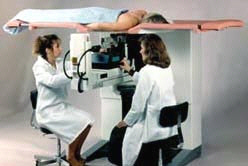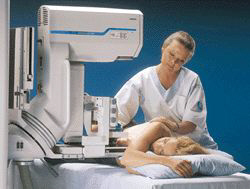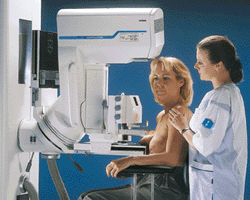- Breast Biopsy Overview
- Digital Spot-View Mammography Improves Breast Biopsy
- Breast Biopsy with Ultrasound Image Guidance
- Breast Biopsy with Prone (Face Down) Stereotactic Image Guidance
- Breast Biopsy with Upright Stereotactic Image Guidance
- Relative Cost of Different Breast Biopsy Methods
Fine needle aspiration (FNA), core needle biopsy, and vacuum-assisted biopsy may be performed using ultrasound (or stereotactic image guidance) if a breast lesion is easily visualized with this method.
Ultrasound is an excellent method of imaging the breasts; ultrasound guidance allows biopsy of the breast from almost any orientation.
During an ultrasound-guided biopsy, small samples of tissue are removed from the breast using a hollow core needle or vacuum-assisted biopsy device that is precisely guided to the correct location using continuous ultrasound imaging. During the procedure, the patient will lie face up on the standard ultrasound table while being modestly draped, exposing only the area of the breast undergoing biopsy. The area is identified by a preliminary ultrasound.
During a prone stereotactic biopsy, the patient lies face down (prone) on a specially designed table with the breast placed through an opening in the tabletop. "Stereotactic" means that the breast biopsy path is imaged from two slightly angled directions to help guide the needle. The tabletop is raised and the radiologist and technologist perform the procedure from beneath. The patient's breast is slightly compressed and held in position throughout the procedure. Several stereotactic pairs of x-ray images are made. Small samples of tissue are then removed from the breast using a hollow core needle or vacuum-assisted biopsy device that is precisely guided to the correct location using x-ray imaging and computer coordinates.
 |
The radiologist and technologist
perform a prone stereotactic biopsy. |
Patients who weigh over 300 pounds are usually not appropriate candidates for biopsies that require the use of the prone table. These patients may be better candidates for upright stereotactic image guidance biopsies.
Breast biopsy using upright stereotactic mammography requires the patient to sit upright in a chair or to lie on her side (lateral recumbent position). The breast biopsy path is imaged from two slightly angled directions to help guide the needle using an upright stereotactic mammography system. The patient’s breast is slightly compressed and held in position throughout the procedure. Several stereotactic pairs of x-ray images are made. Small samples of tissue are then removed from the breast using a hollow core needle or vacuum-assisted biopsy device that is precisely guided to the correct location using x-ray imaging and computer coordinates. Upright biopsy is the best method for guiding a biopsy of the axilla or "tail" of the breast; 41% of breast cancers occur in this region.
Perhaps the most difficult part of a biopsy with upright stereotactic image guidance for many patients is the need to sit upright without moving during the biopsy. Therefore, upright stereotactic mammography may not be a viable option for some elderly, anxious, or physically impaired persons. However, upright stereotactic mammography may be an appropriate method for patients who would find it difficult to climb up onto the prone table.
 |
The patient is in the lateral recumbent position for biopsy using an upright stereotactic mammography system. Image courtesy of Siemens Medical. |
 |
The patient is in the seated position during biopsy using an upright stereotactic mammography system. Image courtesy of Siemens Medical. |
Many health insurance providers cover the cost of a breast biopsy. However, women should always check with their insurance companies before undergoing any medical procedure to determine whether the cost of the biopsy and related costs will be covered (and at what rate). Women should also check to see if special referrals are necessary, as many health maintenance plans require these prior to any specialist consultations or procedures.
The cost of a breast biopsy can range from approximately $1000 to approximately $5000 depending several factors, including the type of biopsy performed, the equipment used during the biopsy, whether image guidance or other additional equipment is necessary to perform the biopsy, etc. The cost of a breast biopsy typically increases as the procedure becomes more invasive. This is due to increases in associated costs of using technologically advanced equipment and forms of anesthesia. The type of facility where the biopsy is performed may also influence the cost. For example, the cost may be higher if the biopsy is performed in an outpatient suite at a hospital versus an outpatient surgical center. Fine needle aspiration (FNA) is usually the least expensive biopsy method while open surgical biopsy tends to be the most expensive.
|
Average Expense for Breast Biopsy |
| 1. Fine
Needle Aspiration (FNA) - least expensive 2. Core Needle 3. Vacuum-Assisted (Mammotome or MIBB) 4. Large Core (ABBI) 5. Open Surgical - most expensive |
Updated: May 4, 2008



